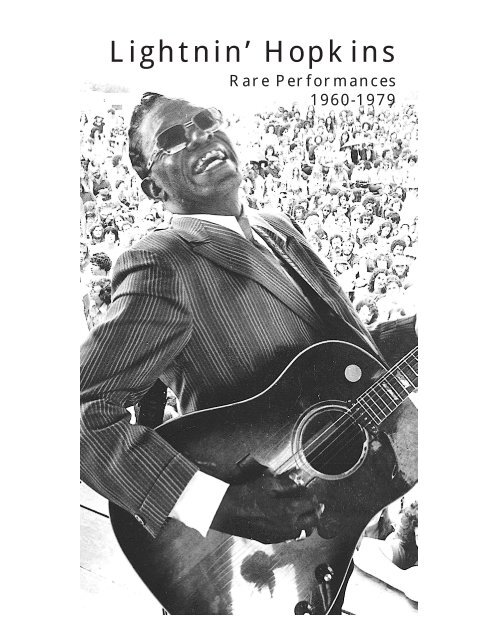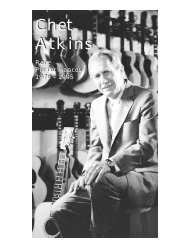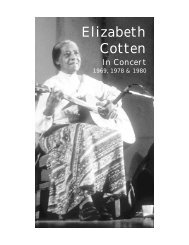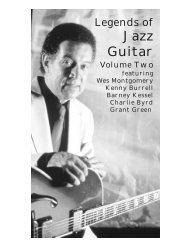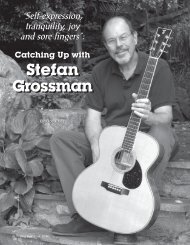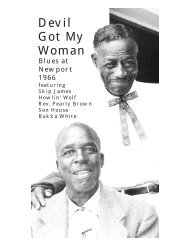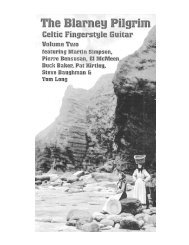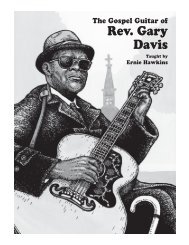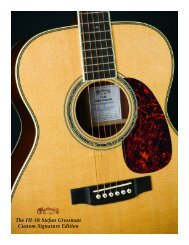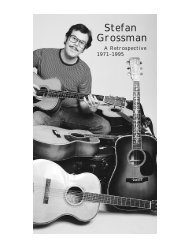Lightnin' Hopkins - Stefan Grossman's Guitar Workshop
Lightnin' Hopkins - Stefan Grossman's Guitar Workshop
Lightnin' Hopkins - Stefan Grossman's Guitar Workshop
You also want an ePaper? Increase the reach of your titles
YUMPU automatically turns print PDFs into web optimized ePapers that Google loves.
Lightnin’ <strong>Hopkins</strong><br />
Rare Performances<br />
1960-1979
New Orleans Jazz & Heritage Festival, 1974<br />
PO’ LIGHTNIN’:<br />
AN APPRECIATION<br />
by Mark Humphrey<br />
I was born March the 15th,<br />
Man, the year was 19 an’ 12.<br />
Yes, you know ever since that day<br />
Po’ Lightnin’ ain’t been doin’ so well.<br />
– Lightnin’ <strong>Hopkins</strong>, “Goin’ Back and Talk to Mama”<br />
The year of Sam <strong>Hopkins</strong>'s birth saw the publication<br />
of the earliest blues on sheet music, including Hart Wand’s<br />
The Dallas Blues. Legend has it, too, that Blind Lemon<br />
Jefferson embarked on his musical wanderings through the<br />
country towns south of Dallas and bordered by the Brazos<br />
and Trinity Rivers at about the same time. 1912, then, was<br />
a banner year for Texas blues. It may be the time celebrated<br />
when Lemon sang: “Blues come to Texas, lopin’ like a<br />
mule.”<br />
Lightnin’ <strong>Hopkins</strong> lived the blues but had little use for<br />
mules. “Plowing that mule for six bits a day,” he would<br />
recall ruefully. “That wasn’t in store for me.” What the future<br />
held for Sam <strong>Hopkins</strong> could have been little guessed<br />
by anyone in Centerville, Texas in the Spring of 1912.<br />
Nearly seventy years later, Lightnin’s death was mourned<br />
worldwide as the passing of a major figure in American<br />
music. Passing with him was much of a tradition he wrested<br />
from men like Jefferson and embellished with his own sharp<br />
2<br />
Photo by Michael P. Smith
wit and implacable personality. Lightnin’s uniqueness made<br />
him a formidable presence in life. Sadly, it also rendered<br />
his a tradition without heirs.<br />
No one came along to extend and elaborate on<br />
Lightnin’s idiosyncrasies in the way he had Jefferson’s,<br />
but that’s not to say he wasn’t influential. Most of the Texasborn<br />
blues singer/guitarists of the post-War era—men like<br />
Freddie King and Albert Collins—point to him as an seminal<br />
influence. Watch Freddie King play on other Vestapol<br />
videos and watch Lightnin’ here: Though the results are<br />
markedly different, both use what might be called ‘the<br />
Texas pinch,’ a heavy thumb-forefinger interaction that<br />
characterizes the picking of most Texas bluesmen. But the<br />
younger men of necessity took Lightnin’s lessons onto<br />
bandstands and into performance situations that demanded<br />
strict meter and a uniformity at which Lightnin’ balked.<br />
Though he would be christened ‘King of Dowling Street’<br />
and live much of his life in urban Houston, Lightnin’ would<br />
always play ‘country,’ if we use that adjective to suggest a<br />
ragged soulfulness that proudly scorned being ‘fenced in’<br />
by musical convention. Lightnin’ played as he felt and for<br />
all his vaunted jiving, never played a note he didn’t really<br />
mean.<br />
His legacy? Over 600 recorded performances. Les<br />
Blank's documentary film, The Blues According to Lightnin’<br />
<strong>Hopkins</strong>. A novel he evidently inspired, Jane Phillips’s Mojo<br />
Hand. And performances like those on this video. Even if<br />
he left no musical heirs, Lightnin’ made sure the world remembered<br />
he’d passed through. More than a decade since<br />
his death, his remains one of the most recognized blues<br />
names, a still-potent synonym for Texas country blues.<br />
“When I play a guitar,” Lightnin’ said in Les Blank’s<br />
The Blues According to Lightnin’ <strong>Hopkins</strong>, “I play it from<br />
my heart and soul...The blues is something that the people<br />
can’t get rid of. And if you ever have the blues, remember<br />
what I tell you. You’re gonna hear this in your heart...”<br />
Hear what? A sharply tremulous riff, a kind of auditory<br />
shudder, followed by a blues sung in a voice Jane Phillips<br />
called “slowly rough and delicately brutal, like stones being<br />
rattled in a can of ribbon cane syrup.” Lightnin’ lived<br />
those country blues, a musical art both intimate and exuberant,<br />
evocative of hard lives from which a few men<br />
wrested powerful bittersweet poetry. They were men we<br />
3
once pictured hunkered over cheap guitars on back porches<br />
or in dim-lit bars, isolated and brooding as they sang to<br />
console themselves as much as to anyone else. (Such a<br />
figure was portrayed on the cover of the influential 1961<br />
Columbia album, Robert Johnson: King of the Delta Blues<br />
Singers.) From the moment of his rediscovery in 1959,<br />
Lightnin’ became, for many of us, the living archetype of<br />
this music. As much as anyone we would see during the<br />
1960s blues revival, he embodied the part.<br />
Lightnin’ had breathed the blues idiom since childhood.<br />
“I had the one thing you need to be a blues singer,” he<br />
once said. “I was born with the blues.” Lightnin’ was inspired<br />
by early encounters with two giants of early recorded<br />
Texas blues, Blind Lemon Jefferson and Alger ‘Texas’<br />
Alexander, a distant cousin. In mythically perfect fashion<br />
Lightnin’ left home early to hobo across Texas, served time<br />
on a chain gang (and earned the scars to prove it), experienced<br />
the indentured servitude of sharecropping and<br />
spent much of his adult life hustling tips with his songs in<br />
Houston bars, street corners, even on buses. Drawing from<br />
a deep well of commonplace verses augmented by a quick<br />
wit for creating fresh ones, Lightnin’ entertained the community<br />
around Houston’s Dowling Street with songs that<br />
reflected their common experience. ‘Po’ Lightnin’,’ as he<br />
called himself in song, became the black Houstonian<br />
Everyman. His endless stream of autobiographical songs<br />
4<br />
Photo by Samuel Charters - Houston, 1974
presented Po’ Lightnin’s troubles, joys and spur-of-themoment<br />
observations on everything from natural disasters<br />
(Hurricane Beulah on this video) to astronauts (the<br />
1962 Bluesville recording, Happy Blues for John Glenn).<br />
“Lightnin’ <strong>Hopkins</strong> can turn the beam of his perception on<br />
a sudden incident,” wrote Paul Oliver in Conversation with<br />
the Blues, “an immediate phenomenon and highlight it in<br />
a spontaneously created blues.”<br />
His reputation spread nationally via recordings and<br />
radio exposure in the early 1950s. A decade later he was<br />
playing Carnegie Hall and being hailed as “the last great<br />
blues singer.” If not that, Lightnin’ was surely one of the<br />
last to display firsthand the imprint of such rustic masters<br />
as Jefferson and Alexander. His raw poetic gift was tireless<br />
and his facile guitar lines much-copied by white admirers<br />
who saw him play endless national (and on rare<br />
occasions, international) tours during the last twenty-some<br />
years of his life. His deeply personal music not only reflected<br />
the experiences of himself and his community but<br />
touched a universal nerve. Chris Strachwitz, who often recorded<br />
Lightnin’, has called his records “brief audio snapshots<br />
of one of the great folk poets to emerge from the<br />
African-American experience in Texas.”<br />
That experience was noted for its brutal cycle of grueling<br />
labor rewarded by grim impoverishment. Music offered<br />
a rare release from it. “I’ve been a poor man all my<br />
days,” Lightnin’ relates between songs on this video. “I<br />
never was born with a dime, nothin’. But I got to hustlin’<br />
and I learned how to knock up on a little change.” His hustle<br />
was blues and the guitar. Lightnin’s first, Jas Obrecht wrote<br />
in a 1982 <strong>Guitar</strong> Player eulogy, was homemade at age<br />
seven from “a cigar box, a plank and chicken wire...” He<br />
picked up the rudiments of guitar from his older brother,<br />
Joel and was already playing competently at age eight<br />
when he first met Lemon Jefferson at a Baptist picnic near<br />
Buffalo, Texas. Lightnin’ vividly recalled the encounter<br />
some 40 years later for Samuel Charters:<br />
“He had a crowd of people around him and I was standing<br />
there looking at him play and I just went to playing<br />
[on] my guitar just what he was playing. So he say, ‘Who’s<br />
that playing that guitar?’ So they say, ‘Oh, that’s just a<br />
little boy here knocking on the guitar.’ He says, ‘No, he’s<br />
playing that guitar,’ says, ‘Where he at? Come here, boy.’<br />
5
Photo by Samuel Charters - Houston, 1959<br />
And I went on over<br />
there where he was<br />
and he’s feeling for<br />
me and I was so low<br />
he reached down and<br />
says, ‘This here is<br />
what was picking that<br />
guitar?’ They say,<br />
‘Yeah.’ So he said, ‘Do<br />
that again.’ So I did<br />
the little note again,<br />
the same one he<br />
done. He said, ‘Well, that’s my note,’ says, ‘that’s the same<br />
thing. Boy, you keep that up you gonna be a good guitar<br />
player.’ So he went on and commenced to playing; so I<br />
went on to playing with him. I was so little and low the<br />
peoples couldn’t see me and we was standing by a truck.<br />
They put me up on top of the truck and Blind Lemon was<br />
standing down by the truck. And me and him, man, we<br />
carried it on...” - Lightnin’ <strong>Hopkins</strong> quoted in The Bluesmen<br />
by Samuel Charters, Oak Publications, New York, 1967.<br />
Following the example of another older brother, John<br />
Henry, Sam dropped out of school to hobo through Texas<br />
and would again cross paths with Jefferson. “I usta play<br />
with Blind Lemon down in Deep Ellum,” he told me in 1980.<br />
“There ain’t no Deep Ellum no more.” Deep Ellum was<br />
Dallas’ version of Storyville, a central Texas red light district<br />
where prostitutes and blues singers plied their trades.<br />
Both Leadbelly and the white Shelton Brothers memorialized<br />
it in song:<br />
When you go down in Deep Ellum<br />
Keep your money in your pants<br />
‘Cause the redheads in Deep Ellum<br />
Never give a man a chance.<br />
- Shelton Brothers, “Deep Elem [sic] Blues,” 1935<br />
By the time Sam <strong>Hopkins</strong> was in his twenties, he was<br />
working a self-made circuit “between Dowling Street and<br />
West Dallas” with stops along the way at such small towns<br />
as Crockett, Brenham, Buffalo and Palestine. If a friend<br />
was going on a trip, Sam might ride in the relative luxury<br />
of a “an old T-model truck.” Sometimes bus drivers who<br />
liked his music offered a lift. And on occasion he simply<br />
hopped freights. “Had to wait my time to get on those freight<br />
6
trains,” he told Paul Oliver in Conversation with the Blues.<br />
“Other boys, they’d run, swing on them things. I couldn’t<br />
do that. See, I always take my guitar with me; I’m scared<br />
I’m gonna bust it. So when it was standin’ still I’d slip in<br />
the box car and ride.”<br />
“I just go from place to place playin’ music for the<br />
dances,” Sam told Oliver. Reeling off names of forgotten<br />
Texas farms with sizable black work crews, he added, “every<br />
one of those farms gave Friday and Saturday night<br />
dances...All you had to do was to rap on your guitar and<br />
they’d pat and holler. Ol’ sister would shout, ‘You swing<br />
mine and I’ll swing yours!’ Sometimes they would have<br />
the blues played, but they most was really dancin’ you<br />
see. Have fast songs like Oh My Babe and Take Me Back...”<br />
Mance Lipscomb first saw Sam in Galveston in 1938,<br />
when he was already a force with whom any visiting ‘songster’<br />
had to reckon. “In Houston he got a big name,” Mance<br />
recalled, “because he was a good songster.” Sometimes<br />
Sam accompanied a veteran of the trade, Alger ‘Texas’<br />
Alexander, his celebrated cousin. An immensely popular<br />
and prolific recording artist in the 1920s and ’30s,<br />
Alexander played no<br />
instrument but often<br />
carried a guitar with<br />
him, should he encounter<br />
a willing accompanist.<br />
Alexander’s fluid<br />
sense of tempo made<br />
him notoriously difficult<br />
to ‘second,’ as Lonnie<br />
Johnson, who worked<br />
with Alexander on several<br />
Okeh recordings,<br />
testified to Oliver: “You<br />
had to be a fast thinker<br />
to play for Texas Alexander.<br />
When you play<br />
out there with him you<br />
done nine days work in<br />
one!” Playing for Alexander was a demanding apprenticeship,<br />
but one which showed Sam the potential rewards of<br />
a blues recording career: Alexander drove the “...first<br />
Cadillac that I ever known to be,” Sam would tell Charters.<br />
7<br />
Photo by Tom Copi
“...everybody admired him, you know, because colored<br />
people didn’t have nothing. They didn’t even have Model-<br />
T Fords then and you know he come in a Cadillac.” (Sam<br />
eventually did his cousin one better. When I met him in<br />
1980, he bragged of owning two Cadillacs!)<br />
Like Alexander, Sam served time on a Houston County<br />
Prison Farm in the late 1930s, an experience the autobiographical<br />
singer would later recall in several recorded titles,<br />
among them Penitentiary Blues, Prison Farm Blues, I Work<br />
Down on the Chain Gang and Prison Blues Come Down on<br />
Me. He told Paul Oliver he served “about coupla hundred<br />
days” on a road gang after a fight (“I was...kinda mean”).<br />
“You go out, catch the mules, hitch the wagon, get right on<br />
down to work,” he recalled. “Every evenin’ when you come<br />
in they would chain you, they’d lock you with a chain<br />
around your leg...you had a bunk of your own and they’d<br />
lock you to a post.” In the time-honored tradition of<br />
Leadbelly, Lightnin’ claimed his music bought his freedom:<br />
“Got away from there by singin’ the blues,” he said.<br />
In 1946, ‘Texas’ Alexander was himself only recently<br />
free from prison when a talent scout, Anne Cullum, heard<br />
him singing on Dowling Street to Sam’s accompaniment.<br />
Cullum had already gotten fellow Houstonian Amos Milburn<br />
on Aladdin Records in Los Angeles and made similar arrangements<br />
for Alexander and <strong>Hopkins</strong>, but reportedly<br />
balked at Alexander’s ‘jailbird’ reputation and replaced him<br />
with pianist Wilson ‘Thunder’ Smith. Singer/pianist Milburn<br />
8<br />
Photo by Don Schlitten
claimed he led Cullum to <strong>Hopkins</strong>, who serenaded him<br />
during a recovery from an auto accident: “One night around<br />
1 a.m. I heard this lonesome guitar down the street and I<br />
said, ‘Who is this guy sounds so good!”’ Milburn told interviewer<br />
Steve Tracey. “And it was Lightnin’ <strong>Hopkins</strong>. So I<br />
got to the window and yelled him over and from that night<br />
on for five nights a week he would sing the blues for me<br />
and that was kind of nice. When I got the [leg] cast off and<br />
everything and I was ready to go, I went over to talk to<br />
Lightnin’. At that time he had a partner playing piano with<br />
him, Thunder Smith. So I went to this lady doctor (Anne<br />
Cullum) and brought Lightnin’ over to let her hear him.<br />
She was inspired also, so we all packed up and took a<br />
train to California.”<br />
It was surely Sam’s furthest trip to date from his beloved<br />
Texas. In the distant city of Los Angeles, he both<br />
recorded and became Lightnin’ for the first time: an Aladdin<br />
recording engineer figured “Thunder and Lightnin”’ would<br />
look catchy on a record label and it was this newly-named<br />
duo which waxed Katie Mae Blues on November 4, 1946.<br />
The Thunder and Lightnin’ team lasted another session and<br />
then Lightnin’, more often than not, was on his own. It suited<br />
him: Like his cousin, ‘Texas’ Alexander, his meters were<br />
quirky and other accompanists would simply crowd the<br />
intimate dialogue between Lightnin’ and his guitar. Back<br />
in Houston, there were other sessions for Aladdin and Imperial<br />
in 1947-48 and then several for Bill Quinn’s Houston-based<br />
Gold Star label between 1948-50.<br />
In 1951, Quinn sold 22 of Lightnin’s Gold Star masters<br />
to Modern Records, then one of the leading labels for<br />
blues and gutsy R&B. The move from a small regional independent,<br />
Gold Star, to the L.A.-based Modern label gave<br />
Lightnin’s records national distribution. His star in the ascendant,<br />
Lightnin’ obliged all comers between 1951-54,<br />
among them Sittin’ In With, Decca, Mercury, and Herald.<br />
Lightnin’ shone as the much-recorded center of a small<br />
group of introspective Texas ‘country’ singer/guitarists—<br />
among them Lil Son Jackson, Frankie Lee Sims and<br />
Smokey Hogg – who enjoyed a brief vogue in the early<br />
1950s.<br />
The blues audience was then almost exclusively black<br />
and its enthusiasm for this music was fueled in ways that<br />
seem ironic today. Urban radio stations targeted at black<br />
9
listeners were still new in the early 1950s and Memphis<br />
station WDIA, self-proclaimed “Mother Station of the Negroes,”<br />
surged with 50,000 watts as one of the nation’s<br />
most powerful. Moohah Williams wore several hats at<br />
WDIA, one of which was Mr. Blues, host of a downhome<br />
blues show entitled Wheelin’ on Beale. Mr. Blues held mock<br />
annual elections for President of the Blues, commanderin-chief<br />
of an august body called the Royal Amalgamated<br />
Association of Chitterling Eaters of America, Inc. for the<br />
Preservation of Good Country Blues. Louis Cantor described<br />
one memorable election in Wheelin’ on Beale<br />
(Pharos Books, New York, 1992): “A spirited contest in 1954<br />
pitted the incumbent President Lightnin’ <strong>Hopkins</strong> against<br />
his upstart challenger Muddy Waters (whom Mr. Blues liked<br />
to refer to as the ‘unclean stream’)...Mr. Blues himself took<br />
a forthright stand for the old order by becoming Lightnin’<br />
<strong>Hopkins</strong>’s Campaign Manager. ‘The forces of destruction<br />
are on the march and are boring from within with an insidious<br />
deadliness,’ he said in an interview just before the<br />
election. ‘We must not be caught unaware. Vote now for a<br />
true blues ticket. Vote for Lightnin’ <strong>Hopkins</strong>.’” History<br />
records that, while Muddy walloped him on the R&B charts<br />
with such stingers as Hoochie Coochie Man in 1954,<br />
Lightnin’ nonetheless retained a loyal constituency at WDIA<br />
and his President of the Blues moniker.<br />
It may have been small consolation, however, as the<br />
black audience for his music (and offers to record it) receded<br />
in the mid-1950s. Yet it was stations like WDIA which<br />
unintentionally opened the door to Lightnin’s next audience.<br />
Radio formats targeted at the African-American<br />
marketplace made a wide range of ‘hidden’ music suddenly<br />
accessible to all Americans. More than ever before,<br />
white listeners could vicariously eavesdrop on black culture<br />
and music. Those with more than a passing curiosity<br />
might even seek out the recordings of artists with such<br />
exotic and sinister sounding names as Muddy Waters and<br />
Howlin’ Wolf. Men like Lightnin’ were fast fading from commercial<br />
favor in the black community, but they were building<br />
an as yet invisible new audience comprised of young<br />
white listeners who tuned in (often over parental objections)<br />
to hear songs that spoke frankly from the far side of<br />
the American Dream. This new audience listened furtively<br />
to static-ridden ‘colored’ stations and thrilled to hear a grim<br />
10
voice bray over a<br />
wiry guitar about a<br />
Mussy-Haired<br />
Woman (a 1956<br />
Lightnin’ single). It<br />
was an entirely<br />
other experience<br />
from hearing Perry<br />
Como croon Round<br />
and Round.<br />
White fascination<br />
with the blues<br />
wasn’t exactly new.<br />
Chris Albertson<br />
paints a vivid portrait<br />
in his Bessie<br />
Smith biography of<br />
‘roaring Twenties’<br />
New York swells<br />
entertained at Carl<br />
Van Vechten’s soirees<br />
by the singing<br />
(and antics) of the blues Empress. John Hammond’s legendary<br />
From Spirituals to Swing concert brought Big Bill<br />
Broonzy, Sonny Terry and other blues ‘primitives’ before<br />
uptown jazz buffs in 1938. Folk and blues enthusiasts<br />
shared a rare common passion in blues. The savvy Broonzy<br />
exploited this, touring Europe in the early 1950s and touting<br />
himself as America’s last living blues singer. But by<br />
1958 Broonzy himself was dead and Muddy Waters’ initial<br />
forays before white blues purists, especially in England<br />
were rejected as aggressive and overamplified. The astonishing<br />
parade of pre-War blues rediscoveries—Son House,<br />
John Hurt, Skip James, Bukka White—was still half a decade<br />
in the future. A trickle of reissue albums, most significantly<br />
the Riverside label Blind Lemon Jefferson Lps<br />
(praised in both down beat and Sing Out!), had whetted<br />
both folk and jazz appetites for authentic country blues,<br />
especially the Texas variety. The stage thus set, Lightnin’<br />
<strong>Hopkins</strong> was about to make a propitious entry.<br />
Samuel B. Charters’ influential book, The Country<br />
Blues, was published in 1959 and closed with a vivid chapter<br />
about Lightnin’, “the last of the great blues singers.”<br />
11<br />
Photo by Tom Copi
Charters had found him in Houston and in January of 1959<br />
there recorded the material for the Folkways album<br />
Lightnin’ <strong>Hopkins</strong> (reissued in 1990 as Smithsonian/Folkways<br />
CD SF 40019). Included was a moving spoken recollection<br />
of Blind Lemon Jefferson and a performance of<br />
Jefferson’s See That My Grave Is Kept Clean. Charters thus<br />
underlined the lineage of a certified legend in Lightnin’s<br />
music. For collectors who revered Jefferson, hearing<br />
Lightnin’ remember him and perform his music was a riveting<br />
experience akin to a later decade’s blues fans hearing<br />
Johnny Shines sing Robert Johnson’s songs. Here was<br />
a living link to a mythic past. Lightnin’s obscurity in Houston<br />
abruptly ended.<br />
Following a recording ‘dry spell’ of nearly three years<br />
duration, the second of eight more 1959 sessions came<br />
only a month after Lightnin’s Folkways recordings, his first<br />
to be marketed to a white urban audience. That audience<br />
was eager to see him perform and got its first glimpse at a<br />
‘hootenanny’ in Houston’s Alley Theatre presented by folklorist<br />
Mack McCormick. In 1960, Lightnin’ made the first<br />
of many tours of the West Coast, performing at the Troubadour<br />
in Los Angeles and the University of California Folk<br />
Festival in Berkeley. He had ventured to New York City<br />
once to record for Sittin’ In With in 1951 and returned for<br />
an eventful month late in 1960, beginning with a Carnegie<br />
Hall concert on October 14th and culminating with his recordings<br />
for Nat Hentoff’s Candid label on November 15th.<br />
12<br />
Photo by Michael P. Smith
(Hentoff remembers Lightnin’ as “calculating. He was meticulous<br />
about mike placement and things. He knew what<br />
he was doing.”)<br />
Lightnin’ certainly made the most of his 1960 visit to<br />
New York City. He performed at the Village Vanguard and<br />
appeared on a CBS television program, A Pattern of Words<br />
and Music. Prior to his Candid session, he had already cut<br />
four LPs (yielding 36 titles) for Bluesville/Prestige, Fire and<br />
Sphere Sound.<br />
His Carnegie Hall appearance was on a ‘folk’ bill featuring<br />
Pete Seeger and Joan Baez, with whom Lightnin’<br />
performed the spiritual, Oh, Mary Don’t You Weep. Incongruous<br />
as that trio may seem in retrospect, it was a PR<br />
coup for Lightnin’ to be seen in such company. Seeger was<br />
the sainted elder statesman of folkdom and Baez its angelic<br />
new diva. Their alliance with the vaunted heir to<br />
Lemon Jefferson provided Lightnin’ entree to legions of<br />
earnest collegiates looking beyond the Kingston Trio for<br />
veins of folk music with deeper roots. The blues revival,<br />
which coincided with the most idealistic years of the Civil<br />
Rights struggle, was beginning to kick in. Lightnin’s presence<br />
gave it a considerable boost.<br />
During this period Lightnin’ made a vivid impression<br />
on Baez’s manager, Manny Greenhill. “In those days I<br />
gambled,” Greenhill recalls. “I’d promise an artist $1,000,<br />
have one booking for them and then hustle.” Having<br />
booked Lightnin’ at Radcliffe University, Greenhill was<br />
shocked to see his untested gamble descend from a Greyhound<br />
bus clutching a cheap and battered Stella guitar in<br />
a paper sack. “I was terrified,” he recalls. “Lightnin’ said,<br />
‘Don’t worry.’ And of course, he was right. I’d never seen<br />
him perform. I had no idea he could coax that caliber of<br />
music from such an instrument.”<br />
Lightnin’ could make do with whatever instrument was<br />
at hand from plywood acoustic boxes to, in his later days,<br />
Fender Stratocasters. In The Country Blues, Charters wrote<br />
of his playing: “The guitar trailed along, echoing the words,<br />
droning in a rhythmic drumming on a lower string, then<br />
ringing above the voice between lines and carrying off<br />
painfully intense, lyric passages between the verses.” John<br />
S. Wilson’s down beat review of Lightnin’s Candid recordings<br />
said: “The subtle nuances of his phrasing, complemented<br />
by his light, spidery guitar patterns, are artistry of<br />
13
the most compelling sort.” (Lightnin’ won the 1962 down<br />
beat International Jazz Critics Poll as New Star, Male<br />
Singer.) Striking as Lightnin’s marriage of voice and guitar<br />
were, his gift for endless lyric invention was his greatest<br />
asset. Certainly it was the one which enabled him to<br />
record 50 songs in a month’s span in 1960 with little repetition<br />
of material. Chris Strachwitz marveled at this “incredible<br />
improvised poetry,” which inspired him to start<br />
Arhoolie, a label on which Lightnin’ often appeared.<br />
Lightnin’s music was essentially a series of conversations<br />
within conversations: Conversations between voice<br />
and guitar; Lightnin’ and a woman; Lightnin’ and himself;<br />
Lightnin’ and the listener. He could be exuberant or slyly<br />
comic, but his most moving performances drew from a<br />
deep well of pained introspection he shared with other Texas<br />
bluesmen of his generation. You hear it, in sharper threads,<br />
in T-Bone Walker’s music and in much of the ‘after hours’<br />
blues that wafted from the West Coast in the 1940s, the<br />
quintessential example being Charles Brown’s 1946 hit,<br />
Drifting Blues. (Lightnin’ ‘countrified’ Brown’s song for Gold<br />
Star as Walking Blues in 1948). Unlike the Southwesterners<br />
who settled in Los Angeles, Lightnin’ remained firmly<br />
rooted in hardscabble Texas soil. His version of this moody<br />
music was elemental and for its starkness, all the stronger.<br />
After 1959, Lightnin’s income-producing career was<br />
tied to performances before white audiences, though he<br />
never stopped playing for his own people in Houston,<br />
where, he said, “I can be broke and hungry and walk out<br />
and someone will buy me a dinner. It ain’t always like that<br />
in a strange place where you don’t know no one.” Lightnin’s<br />
new found celebrity made him a local hero in Houston’s<br />
Third Ward. He was often a feature of Houston’s annual<br />
Junetenth celebration (June 19th is celebrated by black<br />
Texans as the day of emancipation). Local rivals acknowledged<br />
his primacy with a nudge: Juke Boy Bonner recorded<br />
a Look Out <strong>Lightnin'</strong> in 1967, in which he sang: “They tell<br />
me you ‘sposed to be the last of the blues singers, Lightnin’,<br />
but you got to give some room to me.”<br />
Though he preferred staying home, Lightnin’ took his<br />
music to far-flung venues. His English and European appearances<br />
on the 1964 American Folk Blues Festival Tour<br />
were a sensation; he toured Europe as late as 1977, appearing<br />
at the Rotterdam Jazz Festival in the Netherlands.<br />
14
Photo by Don Schlitten<br />
At every opportunity,<br />
he recorded.<br />
Produced by sensitive<br />
admirers like<br />
Charters or Strachwitz,<br />
Lightnin’s ‘rediscovery’<br />
era recordings<br />
yielded<br />
stunning performances<br />
which<br />
equalled any waxed<br />
in the 1940s-<br />
1950s. But given<br />
an indifferent producer and a frank goal of quick cash,<br />
Lightnin’s torrent of 1960s-1970s albums did little to enhance<br />
his reputation.<br />
The flood of Lightnin’ vinyl which glutted Lp ‘cut out’<br />
bins a dozen years ago is long since vanished and the CD<br />
excerpts of his massive oeuvre tend to focus on the best of<br />
his early and ‘rediscovery’ recordings. It is easier to make<br />
sense of Lightnin’s music from the judicious pruning of it<br />
currently at hand than it was from the ‘embarrassment of<br />
riches’ overwhelmingly available in the past. (I recall his<br />
Gold Star/Modern recordings showing up on 8-track tapes<br />
in dime store bargain bins in the 1970s!)<br />
Lightnin’ <strong>Hopkins</strong> died of pneumonia on January 30,<br />
1982 in a Houston hospital. (The previous July he had<br />
undergone surgery for cancer of the esophagus.) My<br />
memory of him is of a blustery man with a storm in his<br />
spirit whose Los Angeles chauffeur I was one weekend in<br />
1980. It was my duty to get Lightnin’ from his hotel to his<br />
gig and back. He traveled with an athletic tote bag (it never<br />
left his side) in which he carried a pint of whiskey and<br />
cans of Pearl, a Texas brew not found outside the Southwest.<br />
“You can’t get that here,” he sniffed in summary dismissal<br />
of L.A.’s provincialism. Lightnin’ wasn’t easily cornered<br />
in conversation, but leapt freely into stream of consciousness<br />
monologues: “I been ever’where a po’ man can<br />
go. I played in Tokyo. Shit, Tokyo! We bombed that son-of<br />
a bitch in the War. But I’m not goin’ back overseas, man.<br />
The people are alright, met some nice people, but it’s the<br />
weather. I was over there one time, it was so cold it froze<br />
my nuts. An’ I ain’t had nothin’ to do with no woman ever<br />
15
since. You think I’m lyin’, but that’s the truth!”<br />
Lightnin’ had little use for other guitarists: “Can’t nobody<br />
talk ‘bout me bein’ jealous of no guitar player,” he<br />
boasted, “‘cause I learned all them sons of bitches how to<br />
play!” Even B.B. King? “Listen at him! He ain’t got but one<br />
tune. He come down to Galveston one time and got all his<br />
stuff from me.” One longtime associate said in admiration,<br />
“Some folks mellow when they get older, but not<br />
Lightnin’! He’ll be scratchin’ n’ bitin’ till the day he dies.”<br />
The sole conversation in which I engaged him began<br />
with me telling him I last heard him play in Oklahoma City.<br />
“Man, that’s a tough town,” he said. “Them cowboys is<br />
rough. Wonder what makes them so rough?” Then we talked<br />
about rodeo clowns and bull riders, sharing a mutual respect<br />
for the badness of cowboys. And once we were talking,<br />
I asked if he would play a song during his performance<br />
that night:<br />
Don’t the moon look pretty,<br />
Shinin’ through the trees?<br />
Don’t the moon look pretty, darlin’,<br />
Shinin’ down through the trees?<br />
I can see my baby, but she can’t see me.”<br />
“You want to hear that?” Lightnin’ said. “Yeah, all right.<br />
You know I remember that. You ask me nice. Now if someone<br />
ask me nice to play somethin’, I do it.”<br />
Lightnin’ honored my request that night and I recall<br />
with gratitude that and the many other occasions when his<br />
music moved me. His bitterness, transformed into music,<br />
gave off an awesome beauty. Lightnin’ made blues as deep<br />
and raw as anyone who ever worked the idiom. Despite<br />
deep chasms of time and culture, his “audio snapshots”<br />
still sear listeners with piquant pains and pleasures: pains<br />
of penitentiaries and sharecropping and loves lost, pleasures<br />
of country frolics and Texas moons shining on sleeping<br />
lovers. Listen. Such poetry as his will not be sung again.<br />
16
Photo by Michael P. Smith<br />
LIGHTNIN’ AS OTHERS SAW HIM<br />
“He moves from one furnished room to another in Houston,<br />
and it’s hard to find out where he’s living...A pawnshop owner<br />
said he knew a Sam <strong>Hopkins</strong>, had his electric guitar in and out...<br />
A thin, nervous man leaned out the [car] window.<br />
‘You lookin’ for me?’<br />
‘You Lightnin’?’<br />
‘That’s right.’<br />
...He sang until he became so tense emotionally that it was<br />
impossible to talk to him. He drank steadily, but he seemed to<br />
play more brilliantly and sing with even greater intensity...<br />
Lightnin’, in his way, is a magnificent figure. He is one of the last<br />
of his kind, a lonely, bitter man who brings to the blues the intensity<br />
and pain of the hours in the hot sun, scraping at the earth,<br />
singing to make the hours pass. The blues will go on, but the<br />
country blues, and the great singers who created from the raw<br />
singing of the work songs and the field cries the richness and<br />
variety of the country blues, will pass with men like this thin, intense<br />
singer from Centerville, Texas.” – Samuel B. Charters, The<br />
Country Blues, Rinehart & Co., New York, 1959.<br />
“Around Houston they enjoy him in an entirely natural way,<br />
flocking to beer taverns to drink and dance and occasionally listen,<br />
and when he rises to the best of what is in him, to cross his<br />
palm with silver...Paradoxically, he is at his best where the audience<br />
is most inclined to ignore him; at a crowded dance hall or a<br />
noisy street corner where he has to compete with distractions, or<br />
must fight to engage the attention of the crowd, and cannot dominate<br />
the situation until he has drawn upon the deepest reserves of<br />
his creative power.”– Mack McCormick, liner notes to <strong>Lightnin'</strong><br />
And Co. Bluesville 1061 (1962)<br />
17<br />
New Orleans Jazz & Heritage Festival, 1974
“Lightnin’ <strong>Hopkins</strong> was perhaps the most inventive and emotional<br />
blues singer I ever met...Throughout the years I have heard<br />
many other great blues singers, but Lightnin’ <strong>Hopkins</strong> has remained<br />
my favorite. I never tire of his records, especially his early<br />
ones, made before I ever met him, and each performance is an<br />
emotional and memorable human experience.” – Chris Strachwitz,<br />
liner notes to Po’ Lightnin’, Arhoolie 1087 (1983)<br />
“I remember Lightnin’ did a couple of tunes about women<br />
wearing rats on their heads: ‘rats’ was a popular name for a way<br />
young women back in the ’50s used to wear a little ball of hair on<br />
their head. In other words, at that time he was kind of current with<br />
what was going on. He was doing things that I wished I could<br />
have done...When I was a disc jockey [on WDIA] and even before<br />
that—the tunes that he was making made me want to really try to<br />
become a blues player.” – B.B. King, <strong>Guitar</strong> Player, June 1982<br />
“His music was...the music of the evening resurrection of an<br />
entire people.” – Jane Phillips, Mojo Hand, Trident Press, 1966<br />
“Lightnin’ <strong>Hopkins</strong> picked up an African hunter’s two-string<br />
fiddle that I had collected in Nigeria and played a blues on it...” –<br />
Paul Oliver, Blues Off the Record, Da Capo Press, New York 1984.<br />
“Lightnin’ <strong>Hopkins</strong> was always one of my idols. I loved him<br />
and he had a lot of influence on me. I’ve got a bigger stack of<br />
Lightnin’ <strong>Hopkins</strong> records than anybody else’s...I remember a long<br />
time ago I was playing a local bar in Houston and one of the frats<br />
came up and said [to Lightnin’], ‘Do you mind playing something<br />
by John Lee Hooker?’ And he said, ‘I am Lightnin’ <strong>Hopkins</strong>. I<br />
don’t play nothin’ else...’ Lightnin’ enjoyed playing for his people<br />
18<br />
Photo by Tom Copi
in Houston...He could have done a lot of things, but he felt a lot<br />
more comfortable drinking and shooting craps with his friends<br />
back in Houston. He’d go out to California or Europe, make a<br />
good bit of money and as soon as the gig’s over, he was back in<br />
Houston. When the money ran out, he’d go on the road again.” –<br />
Johnny Winter, <strong>Guitar</strong> Player, June 1982<br />
“Lightnin’s lined face, usually hidden behind dark glasses and<br />
shaded by a cowboy hat and his chain gang ankle scars testify to<br />
the hardness of his life. His blues are intense but relaxed and<br />
effortlessly so, almost spontaneous conversational revelations of<br />
his own feelings and reaction to the world he has known. He still<br />
plays for country parties as he always has, sitting back with an<br />
air of casual detachment, acutely aware of his own mastery and<br />
artistry. His musicianship still owes something to the childhood<br />
encouragement of his idol Blind Lemon in the irregular guitar patterns,<br />
the suspending of the rhythm to sing and answer the words<br />
with extended runs and in an uncluttered directness of<br />
expression...he remains firmly part of the Houston ghetto, revered<br />
by those who know him, with his gold-capped teeth, straightened<br />
hair and the unforced aura of being his own man.” – Giles Oakley,<br />
The Devil’s Music: A History of the Blues, Harcourt Brace<br />
Jovanovich, New York & London, 1976.<br />
“I did get to play with Lightnin’ <strong>Hopkins</strong> at the Granada Theater.<br />
That was in 1976, ’77. That was fun. He was a grumpy old<br />
coot. I guess he had heard it all...Lightnin’ <strong>Hopkins</strong>, though, could<br />
really play. He was great.” – Anson Funderburgh, quoted in Alan<br />
Govenar’s Meeting the Blues, Taylor Publishing Co., NY, 1988.<br />
“He frequently plays concerts and universities, too and sometimes<br />
dismays his audiences by being as irascible, cantankerous<br />
and downright mean on stage as he is known to be off.” – Bruce<br />
Cook, Listen to the Blues, Charles Scribner’s Sons, NY, 1973.<br />
”Houston was Lightnin’s town...He was leader of Houston’s<br />
Fourth Ward, one of the oldest black sections in Houston and managed<br />
the Fourth Ward Apartments, where he lived for free. He<br />
was regarded throughout the community as just a pillar for being<br />
there so long and being so well respected. He had become famous<br />
and the blacks could relate to his fame because it was<br />
about their own heritage, the blues.<br />
“Lightnin’ always had a new Cadillac. Where he got the<br />
money, nobody knows. He was a real flashy kind of guy—always<br />
dressed in the finest of fine. He had a constant cigar in his mouth<br />
with a little cigar holder. Never without it. In fact, I heard a few<br />
people remark as they passed by his coffin, ‘Yeah, they done a<br />
pretty good job on ol’ Lightnin’, but where’s his cigar?’” – Billy<br />
Gibbons of ZZ Top, <strong>Guitar</strong> Player, 1982<br />
19
20<br />
Photo by Kathy Murray - Austin City Limits, 1979
“WATCH THE STRINGS,<br />
NOW, NOT MY FINGERS”<br />
THE PERFORMANCES<br />
In 1960, German filmmaker Dietrich Wawzyn combed<br />
America shooting footage for a series of West German television<br />
documentaries on American roots music: blues,<br />
gospel, country, New Orleans jazz and Hawaiian music.<br />
Chris Strachwitz went along as sound man and naturally<br />
pointed Wawzyn to Lightnin’. This video opens with probably<br />
his earliest filmed appearance performing an archetypal<br />
Texas blues, Lonesome Road and an atypically minor-keyed<br />
boogie, Lightnin’s Blues, the latter suggesting<br />
his effectiveness as one-man band.<br />
Seven years later, Lightnin’ found himself on display<br />
at the University of Washington Ethnomusicology Department.<br />
There he performed a distinctly Lightnin’-ized Baby,<br />
Please Don’t Go, for which he casually claimed authorship.<br />
Big Joe Williams, who first recorded the song in 1935 would<br />
beg to differ, but Lightnin’ had likely been performing it so<br />
long that it became, in his mind anyway, his song (he first<br />
recorded it for Gold Star in 1948). He could honestly claim<br />
Mojo Hand, which may have been his last hurrah on black<br />
jukeboxes when Bobby Robinson released it as a single on<br />
his Fire label (he waxed it during Lightnin’s eventful 1960<br />
New York City junket).<br />
Lightnin’s vagueness about the song’s meaning (“Lotsa<br />
people wants to know what that is—I ain’t gonna tell ‘em”)<br />
may have been more than mere coyness. Perhaps it meant<br />
any number of things, or nothing in particular. In 1930’s<br />
Talking to My Self, Blind Willie McTell went ferreting after<br />
his mama’s mojo (an apparent double-entendre), while<br />
Muddy Waters sought a magic amulet in the mojo hand of<br />
his 1950 hit, Louisiana Blues. Read Jane Phillips’ Mojo<br />
Hand for one description of this spellbinding device and<br />
the “Mojo Hand” chapter in Robert Palmer’s Deep Blues<br />
for quite another. (Different still is Mack McCormick’s definition<br />
of the mojo hand as “a charm soiled with menstrual<br />
blood, guaranteed to insure fidelity.”) With its quasi-African<br />
name, the mojo hand may be a kind of blues Rorschach<br />
test which needn’t have too precise a definition.<br />
21
Photo by Tom Copi<br />
Take Me Back is the<br />
oldest piece performed<br />
here, a song Lightnin’<br />
used to entertain farm<br />
workers at long-ago<br />
country dances and<br />
which reflects pre-blues<br />
Texas traditions. It was<br />
widely popular with<br />
Lone Star songsters;<br />
Blind Lemon Jefferson<br />
recorded it as Beggin’<br />
Back in 1926 and you<br />
can hear Mance<br />
Lipscomb’s version on<br />
Mance Lipscomb in<br />
Concert (Vestapol<br />
13011).<br />
During the same 1967 visit to Seattle, some of<br />
Lightnin’s music was captured by the Seattle Folklore Society.<br />
Hurricane Beulah is the sort of topical song for which<br />
Lightnin’ was noted, though it can’t honestly be said that it<br />
was made from scratch. Ostensibly a song about one of<br />
the hurricanes which periodically brutalize the Texas gulf<br />
coast, he refers to “a mean ol’ twister” (tornado) which<br />
was actually the title of one of his songs from his debut<br />
Thunder and Lightnin’ session in 1946! He had sung about<br />
Hurricanes Carla and Esther for Arhoolie in 1961 and about<br />
Hurricane Betsy for Verve-Folkways in 1965. Such<br />
catastrophies were inevitable parts of life on the Texas coast<br />
and Lightnin’ could readily recycle lyrics describing an<br />
earlier season’s calamity under the name of the latest hurricane.<br />
His ability to cobble bits of earlier songs into ones<br />
seemingly fresh was a skill at which the prolific Lightnin’<br />
excelled.<br />
The impetus to perform Slim Harpo’s 1965 hit, Baby<br />
Scratch My Back, was simply that it was immensely popular,<br />
one of the last blues performances to enjoy pop ‘crossover’<br />
success and probably much requested in Houston<br />
bars. Lightnin’ gives it his sly best.<br />
Three years after his 1967 Washington appearances,<br />
Lightnin’ gave a memorable performance on Los Angeles<br />
station KCET-TV’s Boboquivari. Couldn’t be Satisfied is a<br />
22
quintessential<br />
Lightnin’ mood<br />
piece, while Questionnaire<br />
Blues is a<br />
fascinating bid for<br />
‘relevance’ before<br />
a young audience<br />
as the Vietnam War<br />
raged. Lightnin’<br />
knew the draft was<br />
unpopular, while<br />
his audience likely<br />
didn’t know he was<br />
remembering lyrics<br />
borrowed from<br />
blues older than<br />
most of them, lyrics<br />
which first<br />
voiced the ambivalence<br />
of black<br />
inductees during<br />
World War II. That<br />
experience stimulated sundry blues about the draft (Lonnie<br />
Johnson cut two fine ones in 1942, Baby Remember Me<br />
and 20 to 44,a title reflecting the age limits of eligible draftees).<br />
Lightnin’ surely remembered them: Legend has it he<br />
was saved from the clutches of Uncle Sam by a stabbing<br />
which hospitalized him on the eve of being drafted!<br />
Ain’t It Crazy was Lightnin’s version of a 1959 Excello<br />
label hit, It’s Mighty Crazy, waxed by Louisiana bluesman<br />
Lightnin’ Slim (Otis Hicks). Shining Moon was a staple of<br />
Lightnin’s repertoire first recorded for Gold Star in 1948.<br />
One of his few songs in which the legacy of Blind Lemon’s<br />
guitar style remained clearly audible, it’s also one of<br />
Lightnin’s most luminously poetic works. Jane Phillips has<br />
her Lightnin’ surrogate, dubbed Blacksnake Brown, perform<br />
it in her novel, Mojo Hand: “Blacksnake raised his<br />
hand and called out solemnly to the moon...he and the<br />
guitar were one, moving and pleading. ‘Don’t the moon<br />
look pretty, shining down through the trees...'”<br />
Black and Evil is a vestige of Lightnin’s association<br />
with ‘Texas’ Alexander. Its provocatively blasphemous lyrics<br />
rework ones Alexander sang in his 1934 recording,<br />
23<br />
Photo by Michael P. Smith - New Orleans Jazz & Heritage Festival, 1974
Justice Blues and later in his final 1950 session’s Bottoms<br />
Blues.Lightnin’s Boogie is a guitar showcase, always a<br />
highlight of his performances, while What’d I Say is<br />
Lightnin’s version of Ray Charles’s huge 1959 hit. (Lightnin’<br />
voiced his admiration of Charles in a 1962 Prestige label<br />
album cut, Me and Ray Charles.) The 1970 performances<br />
close with How Long Has It Been, the nearest thing offered<br />
in these performances to a ‘holy blues.’ Lightnin’ had previously<br />
performed it in the Les Blank film, The Blues According<br />
to Lightnin’ <strong>Hopkins</strong>.<br />
A well-heeled Lightnin’ appeared on Austin City Limits<br />
in 1979, accompanied by Ron Wilson on bass and Bill<br />
Gossett on drums. Along with reprises of Mojo Hand and<br />
Black and Evil, Lightnin’ offered the blues perennial Rock<br />
Me Baby (first recorded in 1950 by Lil Son Jackson as<br />
Rockin’ and Rollin') and some original observations on<br />
women and cars, Ain’t No Cadillac. The 67 year old<br />
Lightnin’ aimed to prove he was an old dude with youngfashioned<br />
ways; note the rakish fedora and his cranking<br />
wah-wah pedal! Note, too, how he seemingly tries to throw<br />
his bass player with his idiosyncratic timing during his solo<br />
on Mojo Hand. (“Black and Evil” indeed!) The ever-resourceful<br />
Lightnin’ revamps Ain’t It Crazy as an outro to<br />
say goodbye to his audience on what was his last video<br />
appearance.<br />
From the Houston streets of 1960 to an Austin<br />
soundstage nearly 20 years later, this video collects a range<br />
of Lightnin’s work, a visual complement to the recordings<br />
Chris Strachwitz calls “brief audio snapshots of one of the<br />
great folk poets to emerge from the African-American experience<br />
in Texas.” We can add to them these vital “video<br />
snapshots” as well.<br />
– Mark Humphrey<br />
For help with background material,<br />
thanks to Mary Katherine Aldin.<br />
24
“I WAS JUST TOO TOUGH”<br />
In the Les Blank film, The Sun’s Gonna Shine, Lightnin’ is seen<br />
surveying a country town’s main street next to a sign:<br />
“Centerville—population 836.”<br />
“Centerville, Texas is my home. Ain’t too much to tell<br />
you about it. It’s just a little ol’ one horse town. Born and<br />
raised there. Didn’t stay there long. Left there when I was<br />
eight years old. I went back when I was 12; leave again.<br />
Just travelin’. I didn’t get no schoolin’, man. I got my education<br />
by sittin’ around talkin’ and lookin’ at what this one<br />
do and what that one do. You go to that field, there was<br />
your school with that hoe and plow that mule. Chop that<br />
cotton. Well, I said I wasn’t going to do it. I didn’t. I was<br />
just too tough. Why, I just know’d there was something in<br />
store for me, man. It wasn’t nothin’ on the end of that hoe<br />
handle for me. Chopping cotton, plowing that mule for six<br />
bits a day. That wasn’t in store for me.”<br />
25
LIGHTNIN’ HOPKINS<br />
RARE PERFORMANCES - 1960-1979<br />
1. LONESOME ROAD<br />
1960 (filmed by Dietrich Wawzyn in Houston, Texas)<br />
2. LIGHTNIN’S BLUES<br />
1960 (filmed by Dietrich Wawzyn in Houston, Texas)<br />
3. BABY PLEASE DON’T GO<br />
1967 (University Of Washington)<br />
4. MOJO HAND<br />
1967 (University Of Washington)<br />
5. TAKE ME BACK<br />
1967 (University Of Washington)<br />
6. HURRICANE BEULAH<br />
1967 (Seattle Folklore Society)<br />
7. BABY, SCRATCH MY BACK<br />
1967 (Seattle Folklore Society)<br />
8. COULDN’T BE SATISFIED<br />
1970 (Boboquivari - KCET-TV Los Angeles, California)<br />
9. QUESTIONNAIRE BLUES<br />
1970 (Boboquivari - KCET-TV Los Angeles, California)<br />
10. AIN’T IT CRAZY<br />
1970 (Boboquivari - KCET-TV Los Angeles, California)<br />
11. SHINING MOON<br />
1970 (Boboquivari - KCET-TV Los Angeles, California)<br />
12. BLACK AND EVIL<br />
1970 (Boboquivari - KCET-TV Los Angeles, California)<br />
13. LIGHTNIN’S BOOGIE<br />
1970 (Boboquivari - KCET-TV Los Angeles, California)<br />
14. WHAT'D I SAY<br />
1970 (Boboquivari - KCET-TV Los Angeles, California)<br />
15. HOW LONG HAS IT BEEN<br />
1970 (Boboquivari - KCET-TV Los Angeles, California)<br />
16. MOJO HAND<br />
1979 (Austin City Limits - KLRU-TV Austin, Texas)<br />
17. AIN’T NO CADILLAC<br />
1979 (Austin City Limits - KLRU-TV Austin, Texas)<br />
18. BLACK AND EVIL<br />
1979 (Austin City Limits - KLRU-TV Austin, Texas)<br />
19. ROCK ME BABY<br />
1979 (Austin City Limits - KLRU-TV Austin, Texas)<br />
20. Good Night Blues<br />
1979 (Austin City Limits - KLRU-TV Austin, Texas)<br />
BONUS TRACKS:<br />
21. Baby, Come Go Home With Me<br />
1960 (TV Special - New York City)<br />
22. Going Down Slow<br />
1960 (TV Special - New York City)<br />
23. Bunion Stew<br />
1960 (TV Special - New York City)<br />
24. Let's Pull A Party<br />
1960 (TV Special - New York<br />
26
Photo by Ed Badeaux<br />
27
From Blind Lemon Jefferson<br />
to Freddie King, Texas gave<br />
the world generations of<br />
extraordinary blues singerguitarists,<br />
of whom none<br />
made a deeper impression<br />
than Sam ‘Lightnin’’ <strong>Hopkins</strong><br />
(1912-1982). He was the<br />
embodiment of Texas country<br />
blues and inspired novelists,<br />
filmmakers, and of course,<br />
countless blues singerguitarists.<br />
The stunning impact<br />
of his charismatic performances<br />
comes fully to life<br />
in this DVD tracing Lightnin’s<br />
career subsequent to his rediscovery<br />
in 1959.<br />
Samuel Charters found him on hard times in Houston and brought ‘Po’<br />
Lightnin” to the attention of white folk audiences. In 1960 German filmmaker<br />
Diet-rich Wawzyn captured Lightnin’ on his Houston home turf, and the clips<br />
here of him performing on the street and in a Houston bar are rare glimpses<br />
into his milieu (and the earliest known footage of <strong>Hopkins</strong>). Seven years later<br />
a relaxed Lightnin’ delivered engaging folk-blues performances for Seattle<br />
folklorists, five of which appear here. In 1970 he painted a masterful and<br />
entertaining musical self-portrait in eight songs from the Los Angeles PBS show<br />
Boboquivari. Finally, Lightnin’s “lion in winter” appearance on Austin City<br />
Limits in 1979 shows a still-powerful country bluesman disproving the old<br />
dog/new tricks adage with a Stratocaster and wah-wah pedal! Four rare<br />
performances from a 1960 TV show are included as bonus tracks. This<br />
collection offers a fresh reflection of one of the most deeply creative and<br />
entertaining characters who ever sang and played the blues.<br />
1. Lonesome Road<br />
2. <strong>Lightnin'</strong>s Blues<br />
3. Baby Please Don't Go<br />
4. Mojo Hand<br />
5. Take Me Back<br />
6. Hurricane Beulah<br />
7. Baby, Scratch My Back<br />
8. Couldn't Be Satisfied<br />
9. Questionaire Blues<br />
10. Ain't It Crazy<br />
11. Don't The Moon Look Pretty<br />
12. Black And Evil<br />
13. <strong>Lightnin'</strong>s Boogie<br />
Running Time: 70 minutes • B/W and Color<br />
Cover Photographs: Michael P. Smith<br />
Nationally distributed by Rounder Records,<br />
One Camp Street, Cambridge, MA 02140<br />
Representation to Music Stores<br />
by Mel Bay Publications<br />
® 2001 Vestapol Productions<br />
A division of<br />
<strong>Stefan</strong> <strong>Grossman's</strong> <strong>Guitar</strong> <strong>Workshop</strong> Inc.<br />
14. What'd I Say<br />
15. How Long Has It Been<br />
16. Mojo Hand<br />
17. Ain't No Cadillac<br />
18. Black And Evil<br />
19. Rock Me Baby<br />
20. Good Night Blues<br />
BONUS TRACKS:<br />
21. Baby, Come Go Home With Me<br />
22. Going Down Slow<br />
23. Bunion Stew<br />
24. Let's Pull A Party<br />
Vestapol 13022<br />
ISBN: 1-57940-914-8<br />
0 11671 30229 4


